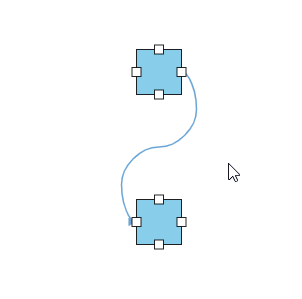Bezier Connector Settings
10 Dec 20245 minutes to read
How to edit bezier segments based on bezier connector settings
The intermediate point of two adjacent bezier segments can be edited interactively based on the segmentEditOrientation property of bezierSettings.
| SegmentEditOrientation value | Description | Output |
|---|---|---|
| Bidirectional | It allows the intermediate points to be dragged in either vertical or horizontal directions. |  |
| Freeform | It allows the intermediate points to be dragged in any direction. |  |
The following code illustrates how to interact with Bezier efficiently by using the smoothness and segmentEditOrientation properties of the bezierSettings.
import { Component, ViewEncapsulation, OnInit, ViewChild } from '@angular/core';
import { DiagramModule, DiagramComponent, Diagram, NodeModel, ConnectorModel, ConnectorEditing, ConnectorConstraints,
PointPortModel, BezierSmoothness, PortVisibility, ShapeStyleModel } from '@syncfusion/ej2-angular-diagrams';
Diagram.Inject(ConnectorEditing);
@Component({
imports: [
DiagramModule
],
providers: [ ],
standalone: true,
selector: "app-container",
template: `<ejs-diagram #diagram id="diagram" width="100%" height="600px" [getNodeDefaults]='getNodeDefaults' [getConnectorDefaults] ='getConnectorDefaults'>
<e-nodes>
<e-node id='Start' [offsetX]=250 [offsetY]=150 [ports]='StartPort'>
<e-node-annotations>
<e-node-annotation content="Start">
</e-node-annotation>
</e-node-annotations>
</e-node>
<e-node id='End' [offsetX]=250 [offsetY]=350 [ports]='EndPort'>
<e-node-annotations>
<e-node-annotation content="End">
</e-node-annotation>
</e-node-annotations>
</e-node>
</e-nodes>
<e-connectors>
<e-connector id='connector1' type='Bezier' sourceID='Start' targetID='End' sourcePortID='StartPort' targetPortID='EndPort'>
</e-connector>
</e-connectors>
</ejs-diagram>`,
encapsulation: ViewEncapsulation.None,
})
export class AppComponent {
@ViewChild('diagram')
public diagram?: DiagramComponent;
public StartPort?: PointPortModel[];
public EndPort?: PointPortModel[];
ngOnInit(): void {
this.StartPort = [{
id: 'StartPort',
visibility: PortVisibility.Visible,
shape: 'Circle',
offset: { x: 1, y: 0.5 },
style: { strokeColor: '#366F8C', fill: '#366F8C' },
}];
this.EndPort = [{
id: 'EndPort',
visibility: PortVisibility.Visible,
shape: 'Circle',
offset: { x: 0, y: 0.5 },
style: { strokeColor: '#366F8C', fill: '#366F8C' },
}];
};
public getNodeDefaults(node: NodeModel): void {
node.height = 100;
node.width = 100;
node.shape = { type: 'Basic', shape: 'Rectangle' };
((node as NodeModel).style as ShapeStyleModel).fill = '#6BA5D7';
((node as NodeModel).style as ShapeStyleModel).strokeColor = 'White';
};
public getConnectorDefaults(connector: ConnectorModel): void {
connector.targetDecorator = { shape: 'None' };
connector.constraints = ConnectorConstraints.Default | ConnectorConstraints.DragSegmentThumb;
connector.bezierSettings = {
smoothness: BezierSmoothness.SymmetricAngle,
segmentEditOrientation: 'BiDirectional',
};
};
}import { bootstrapApplication } from '@angular/platform-browser';
import { AppComponent } from './app.component';
import 'zone.js';
bootstrapApplication(AppComponent).catch((err) => console.error(err));